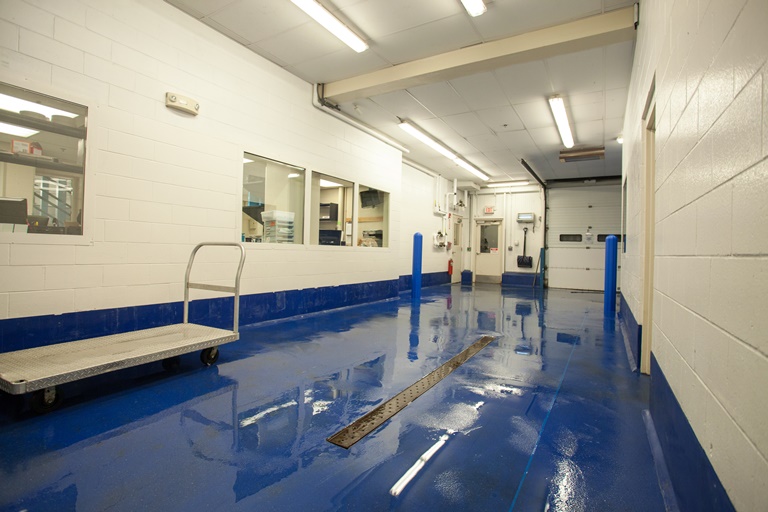The color blue is often associated with the sky, the sea, and several types of fish. It should be no surprise then, that when the owners of Boston Sword & Tuna needed a new floor, they went for something blue there, too. That the chosen floor was also chemical resistant and antimicrobial made it one great catch!
Barramonday
Tim Malley and the Scola brothers (Michael, Paul, and Stephen) joined in 2006 to form Boston Sword & Tuna. The company has a two-ship fleet that catches swordfish, tuna, Norwegian salmon, lobster, sea scallops, and groundfish. It’s a busy facility; according to their website, they are “one of the nation’s premier seafood distributors.” The goods are brought into the facility where they are — to keep it simple — broken down, packaged, and shipped out, according to Silvio Coccia, Jr., president of Sil-Mar Construction Corp. So when the bare concrete floors were corroding, Boston Sword & Tuna needed a solution that could handle the facility’s pressure.
“Most of the existing floors had no topping or coating,” explained Coccia of the approximately 10,000-square-foot (929 m²) total project, which was done over several mobilizations. “It was just corroded concrete, and our job was to scarify it and install new Flowcrete topping to protect against wash-downs and chemical cleaning agents.” With all of that seafood coming through this facility, the new floors needed to be able to withstand everything that was going to hit it — pallets,  forklifts, and ice tubs. Oh my! And, with only three days at a time to get in and get out in any given area, using a coating that didn’t require a primer or topcoat certainly helped keep this coatings crew on point.
forklifts, and ice tubs. Oh my! And, with only three days at a time to get in and get out in any given area, using a coating that didn’t require a primer or topcoat certainly helped keep this coatings crew on point.
“We only had three-day weekends and they had to get back on it Monday morning,” Coccia said. The facility had to keep functional during the work week, so the coatings crew made sure to get their part done as quickly as possible. That meant a lot of coordination between the plant and the applicators. If Sil-Mar Construction Corp. was working in one area over the weekend, then the facility workers would stay in a different area during the week. “We were isolated and confined in our own areas — not easy,” said Coccia. They’d complete an area that was given to them and then return at a later date for the next given area.
As Coccia succinctly put it, this job was “nothing special. That’s what we do: get in and get out.”
Wet and Wild
Even with the coordination of the rooms between the coatings crew and the facility workers, which Coccia planned with the owners before the job started, the Sil-Mar Construction Corp. crew had other issues to address.
First of all, this project was done in Boston…through the New England wintertime. That meant that the floors needed to be heated to hit the minimum temperature required to install the Flowfresh HF. The 8- to 10-person crew used temporary electric heaters from Grainger’s Fostoria line to warm the substrate. They were 440 volts.
Second, because of the nature of what these facility floors are used for and the poor condition of the original concrete, the crew also had to deal with wet substrates. They used fans and blowers to dry the concrete. “It was definitely a challenge,” Coccia said.
Once they were set to go, the crew forged ahead.
Wearing dust protection, safety glasses, hard hats, and gloves, the crew prepared the substrate with scarifiers. Then, using tools from Marshalltown, they hand-troweled the Flowfresh HF at an average of 3/8ths inch (1 cm). Although the facility might later house a bit of a fishy smell, the coatings had no odor, so that wasn’t going to be a problem while the crew worked from one room to the next.
“The floor that Flowcrete Americas supplied to Boston Sword & Tuna had to be able to meet multiple requirements in what is a challenging environment, as exposure to cold temperatures, heavy equipment, fluid spillages, and fish by-products would all have to be accounted for on a daily basis,” said Dave McNeece, managing director for Flowcrete Americas. The urethane coating used in this facility is resistant to thermal shock, something that could be quite common during the cleaning of the seafood.
The coating is also made with Polygiene, a silver-based antimicrobial, antifungal additive. According to a Flowcrete write-up, Polygiene “can positively inhibit the growth of gram positive and gram negative bacteria including SARS [severe acute respiratory syndrome], E-coli, MRSA [Methicillin-resistant Staphylococcus aureus], C. difficile, and Salmonella typhi amongst others.” The coating is also heat- and slip-resistant. Added to the more than 30 years of experience of Easton, Pennsylvania-based Sil-Mar Construction Corp., this seemed like the perfect combo for this client.
A Daily Special
According to a Flowfresh release, Michael Scola, Boston Sword & Tuna’s president, said, “We were looking for a floor that was going to last; we wanted the materials to be very strong. Sometimes you have the concrete and you get a crack, and then water gets underneath it. With this product, that doesn’t happen.”
In a facility where freight, feet, and fish can hit it every day, it was crucial to find a floor that would work. The fact that the Sil-Mar Construction Corp crew could deliver an effective floor that was also blue? Well, that was special. It made quite a splash!
